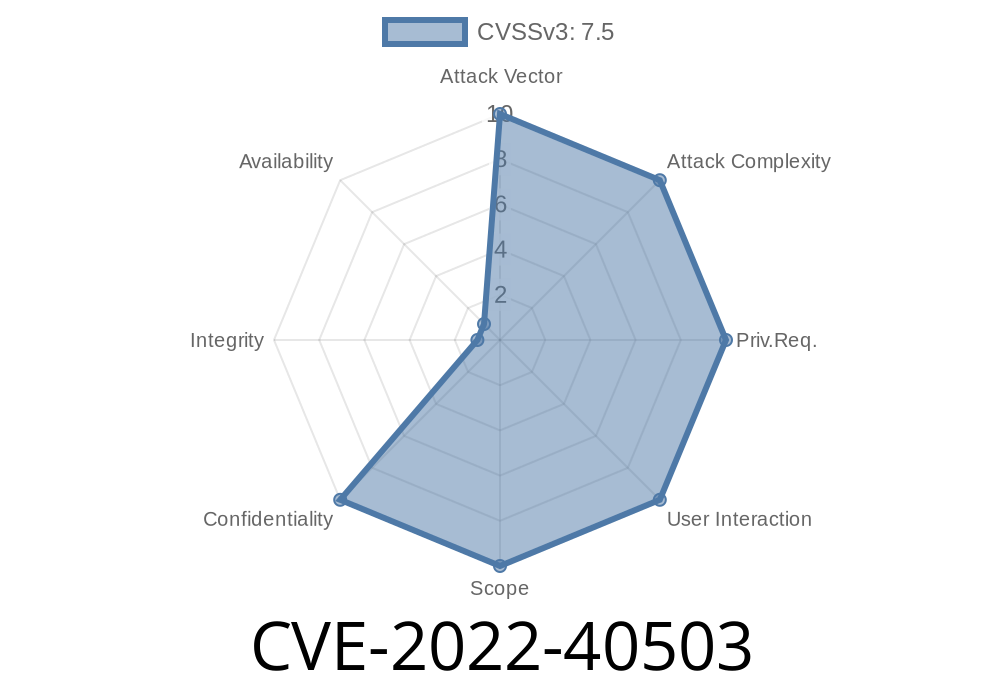CVE-2022-40503 is a recently discovered vulnerability that affects the Advanced Audio Distribution Profile (A2DP) in Bluetooth Hosts. This vulnerability potentially allows unauthorized access to sensitive data, which can lead to critical information disclosure. In this post, we'll discuss the root cause of this vulnerability, explore the code snippet that demonstrates the issue, and provide the necessary references for understanding the exploit details.
Background
The Advanced Audio Distribution Profile (A2DP) is a Bluetooth profile that enables wireless transfer of high-quality audio between devices. It is commonly used in smartphones, tablets, and laptops to stream audio to wireless headphones or speakers.
Vulnerability Details
The vulnerability in question, CVE-2022-40503, is caused by a buffer over-read issue in the Bluetooth Host while A2DP streaming. This means the affected software reads data past the allocated buffer, causing an accidental exposure of sensitive data. An attacker who exploits this vulnerability can potentially gain unauthorized access to the Bluetooth Host software's memory, leading to the disclosure of sensitive information, such as encryption keys, memory addresses, or user data.
Let's take a closer look at the code snippet that demonstrates the buffer over-read issue
// Function handling the A2DP streaming
void a2dp_streaming_handler (uint8_t* data, size_t data_length) {
// Buffer allocated for a fixed size
uint8_t buffer[1024] = {};
size_t buffer_length = sizeof(buffer);
// Incorrectly assuming that data_length <= buffer_length
memcpy(buffer, data, data_length);
// Process the received data
process_a2dp_data(buffer, data_length);
}
In the above code snippet, the a2dp_streaming_handler() function receives a data pointer data, which holds the data to be used for A2DP streaming, along with the data_length indicating the number of bytes in the data. The function allocates a fixed-size buffer and copies the data content into the buffer using memcpy(). The critical issue in this code is the assumption that data_length will always be less than or equal to the buffer length, which is not enforced. If an attacker could manipulate the data_length variable, it would result in a buffer over-read, causing the disclosure of adjacent memory content.
Exploit Details
The CVE-2022-40503 vulnerability can be exploited in a few different ways. One possible approach is using a specially crafted Bluetooth packet to trigger the buffer over-read. By sending malformed data to the target device, an attacker can potentially cause it to read memory content beyond the allocated buffer. This info can be used to obtain sensitive data or to launch further attacks, such as code execution, to control the target device fully.
Mitigations
To address CVE-2022-40503, software vendors should enforce strict checks on the received data length and ensure it does not exceed the bounds of the allocated buffer. Additionally, they should apply the latest security patches regularly and update their Bluetooth implementations following the best practices recommended by the Bluetooth Special Interest Group (SIG).
References
For more information on CVE-2022-40503 and understanding the in-depth details of this vulnerability, please check the following links:
1. Official CVE Details: https://cve.mitre.org/cgi-bin/cvename.cgi?name=CVE-2022-40503
2. National Vulnerability Database (NVD): https://nvd.nist.gov/vuln/detail/CVE-2022-40503
3. Bluetooth SIG Advisory: https://www.bluetooth.com/learn-about-bluetooth/bluetooth-technology/technical-resources/security/
Conclusion
CVE-2022-40503 highlights the importance of carefully validating data received over Bluetooth connections, especially in situations where sensitive information is involved. It is crucial for software vendors to be aware of such vulnerabilities and take the necessary precautions to ensure that their software is secure against potential attacks. By understanding and mitigating this vulnerability, we can better protect our devices and data from unauthorized access and information disclosure.
Timeline
Published on: 04/13/2023 07:15:00 UTC
Last modified on: 04/24/2023 15:50:00 UTC
